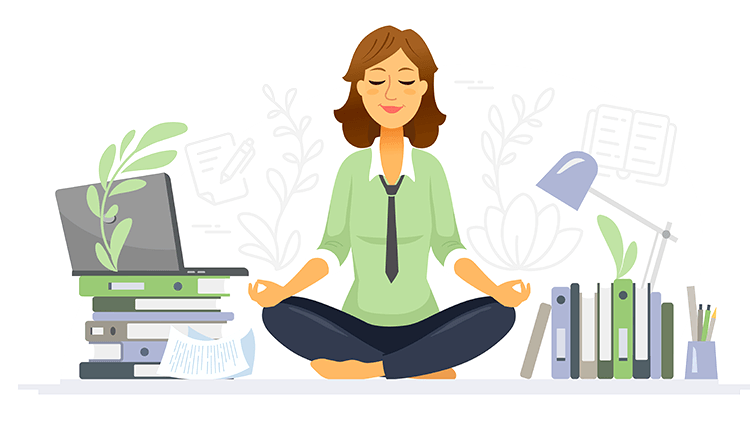Studies show that people spend almost 47% of their day thinking about something other than what they’re doing. Being mindful means the exact opposite: having focus and awareness of the world around us. If we all practiced mindfulness and were more present throughout our day, we’d find ourselves happier and more productive.
Mindfulness is a key component of mental health and fortunately, is something you can improve in just a few small steps each day. Discover how to stay mindful while working with these tips:
Complete a mindfulness exercise
Train your brain to focus better by completing short mindfulness exercises. One of the most effective mindfulness exercises requires focusing on your breathing: Sit at your desk and close your eyes. Now, focus on your breaths. Take long, deep breaths, inhaling and exhaling. If you have a stray thought enter your head, accept that thought, then turn your attention back to your breath. Spend five to ten minutes doing this exercise.
Yoga moves are another example of a mindfulness exercise, and in many cases can be done from your desk. Try the crescent moon pose, which requires interlacing your fingers and extending your arms above your head into a stretch. You can also try wrist and finger stretches, or any combination of moves that work best for you. While doing these moves, still maintain focus on your breathing and reducing distracting thoughts.
Complete a mindfulness exercise at the very beginning of your workday, and ideally a few more times throughout (especially when you’re stressed). The goal is to coach your brain into being more focused on the task at hand and less affected by distractions and stress. Expect to feel calmer and more engaged after each exercise.
Single-task, slowly
Multitasking used to be paraded as the most productive method for accomplishing a lot of tasks in a set period of time. More recent and respected research shows, however, that this isn’t the case. In fact, single-tasking has now been proven to be much more effective.
If you’re in the habit of multitasking, don’t take our word for it: block time for multitasking, and block separate time for single-tasking. After each block, record how many tasks you accomplished. In theory, you should discover that you’ve accomplished more by single-tasking.
Why is this the case? When you’re multitasking, you’re more likely to make mistakes and deliver lower quality work. You’re doing two things with half of your effort given to each, rather than one thing with all of your effort. You’re also more likely to make errors when you’re rushing to finish tasks. You’ll have to go back and correct these errors eventually.
Practice mindfulness by slowing down. Be more methodical as you work through your to-do list and you’ll discover how much more efficient you can be when you’re not trying to do several things at once.
Choose to be present
Remember that 47% statistic? Many of us operate on auto-pilot while working. As a consequence, we’re unaware of the opportunities we may be missing, and cannot respond creatively to the choices put in front of us. Being more present during our day helps with both our memory and our reactions.
You must make a proactive choice to be present; it won’t happen naturally. Some experts suggest even saying a mantra to yourself before starting work, such as “I will fully show up and be present today.” By committing to this goal out loud, you’re more likely to follow through.
One way of being present while interacting with others is through active listening. Active listening requires being patient and nonjudgmental. To be an active listener, you should be asking questions of the speaker, clarifying points, repeating statements back to them, and summarizing what was said. Practice these actions and you’ll have a hard time forgetting your social interactions.
Aim for growth
A fixed mindset means you feel your personality and skills are unchangeable: you are what you are. Adopting a growth mindset means subverting this concept and understanding that you’re a work in progress. You can always develop your skills further and change aspects of your personality to better suit your personal and professional goals.
To work on your growth during a workday, learn to listen to your fixed voice and recognize it for what it is. By paying attention to your inner dialogue, you’ll be able to filter out the thoughts that aren’t productive for your development. Start by questioning what that fixed voice is saying. Understand that that fixed voice is wrong and that you do have a choice in how you conduct yourself; your traits and abilities are, in fact, changeable.
Finally, take action. If your professional goals require you to be more assertive or to learn a new skill, make a plan for accomplishing these items. Document measurable, reasonable goals to help you achieve what you want.
Embrace positive thinking
If you’re tired of hearing the phrase “be positive!” as a mental health tip, it’s probably because that phrase is far too general to have a meaningful impact. Instead, here are a few practical, specific pieces of advice that will help you embrace positive thinking in your life:
- Find high points during your day (even if it’s just your next break)
- Be accountable for your own mistakes
- Accept what you can’t change
- Remember that no one owes you anything
- Embrace learning new skills and processes
- Focus on the long-term, don’t dwell on the short-term
- Don’t rely on others for positivity
Work on each of these actions, and you’ll eventually notice a change in your inner voice toward the positive. Positive thinking is an acquired trait (there’s a reason humans have a negativity bias) and is something you’ll need to practice to excel at. Luckily, you now have the tools with which to do so.
—
Interested in exploring flexible, work-from-home jobs? Appen is hiring!



